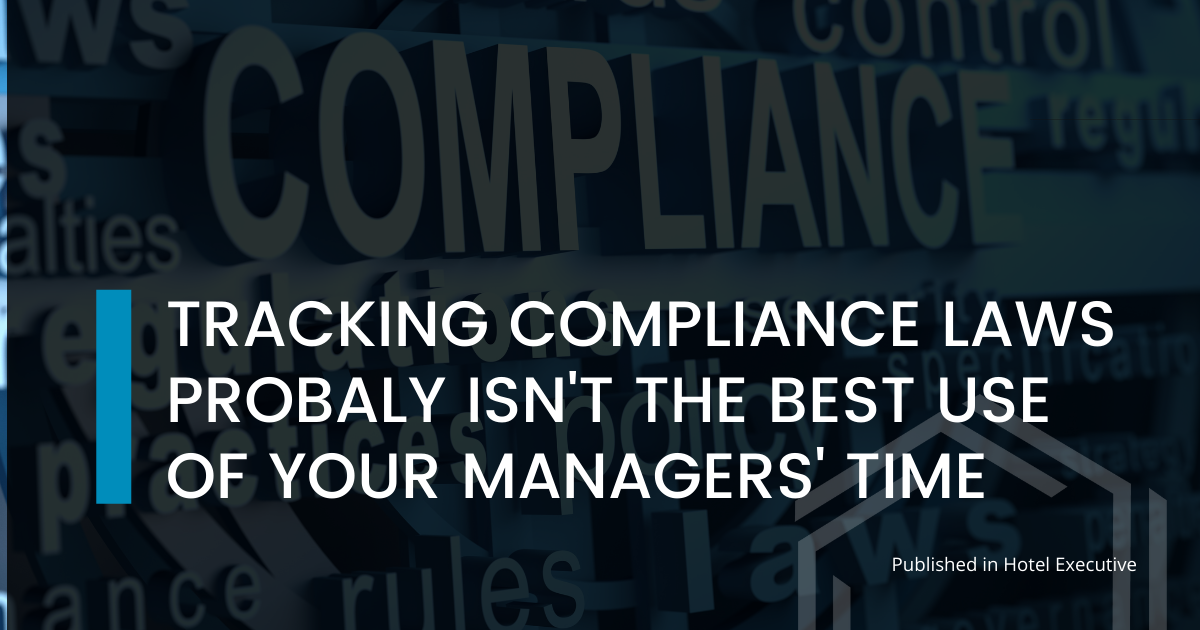Published in Hotel Executive - March 6, 2022 - Ask any hospitality-based manager what takes up a majority of their workday and the answer is likely to be routine processes such as employee scheduling which while essential to business operations, represent an inefficient usage of time.
Central to this issue with regards to scheduling is the ever-increasing scope and complexity of labor rules and regulations that a manager must ensure compliance with at all times and for each employee.
As acquiring employees and maintaining their loyalty also becomes more competitive as a result of the labor shortage brought on by the pandemic and a shift in the demography of the workforce, adhering to labor rules has also become even more crucial to preserving an adequately staffed workforce.
Yet while labor laws are designed to provide employees with a fairer work/life balance, the simple truth is that they are also responsible for ballooning the multitude of variables that a manager must consider before they can create a compliant schedule. Add to this the challenge of having to ensure compliance with each individual employee, which can often number in the hundreds or thousands, and managers will soon find that entire days can be lost to ensuring that each and every labor rule nuance is correctly implemented.
At the current stage of technology progression in the hotel market, there is a better way. Hoteliers are no longer required to manually track and apply each and every labor rule that comes into effect. Significantly, they can finally regain the time needed to focus on providing their guests with exceptional experiences that lead to higher profits and business growth.
A Brief History on the Evolution of Labor Laws
One aspect of labor laws and regulations that hoteliers have to keep in mind is that they are constantly changing and are gaining an ever greater influence on scheduling-related decisions. Consider that among the first labor laws implemented were with regards to the hiring of children. At the time, employers only had to consider the implications of when and where to utilize minors if at all possible.
Now, there is a growing influx of labor laws that go far beyond age restrictions and can include requiring that employees are given breaks and lunches based on the number of hours they work in a day. Other examples can further consist of needing to prevent employees from working over a certain number of days in a row. Even if an employee has worked less than forty hours during a given week, any attempts to schedule them more than five days in a row, for example, may lead to the requirement of paying overtime.
Making matters even more complicated, is the fact that labor laws are not evolving in a universal fashion but can vary dramatically by state or locality. Take for instance, the growing prevalence of fair workweek laws. Several states such as New York and California now require employers to plan schedules weeks in advance, with the ability to make any subsequent changes either highly restricted or subject to a penalty.
Other states may not currently have any fair workweek laws, but rest assured, they are coming. Yet even for states that have adopted them, the substantial disparity over what each regional law mandates can easily cause confusion and an increased risk of falling into non-compliance. This is especially true for companies operating within several different regions, with each business locale having to instantly and consistently adapt to any ongoing fluctuations in regional law.
Already strapped for time, it is simply impractical to expect that managers by themselves can keep up with all the legal nuances that may or may not come their way and affect their scheduling strategy. Without the use of technology, the only sure thing to result from this approach is inconsistent application of rules and management personnel with little or no time to focus on anything else coupled with the additional costs of penalties for non-compliance.
How Technology Comes into Play
In today's industry, hoteliers are performing a disservice not just to their managers but to the overall health of their business if they continue to rely on manual scheduling processes. For example, the previous discussion on having to conform to child labor laws dictating where and when minor employees can be utilized. Imagine the countless hours spent by managers trying to determine if certain employees are able to work after a specific hour of the day or night. Depending on the region, such rules may differ depending on the specific age of an employee. Some municipalities may even have rules for minors attending a specific school that requires them to be off the clock by a pre-determined time.
Replacing such potential headaches and penalty risks are consequently advanced labor management and time & attendance platforms that can instantly take the guesswork out of any scheduling decision when it comes to employing minors. These newer technologies notably are equipped with state-of-the-art artificial intelligence that, unlike their human counterparts, can analyze any number of potential scenarios and labor law conflicts in mere seconds. Without any managerial involvement, today's more advanced platforms can automatically identify an employee's age and the specific regionalized rules that apply to scheduling them, with an alert instantly provided to managers if an action they are attempting to perform violates regulations.
The same enhanced functionality applies to virtually any labor rule, regardless of whether a business has to take just one or multiple regional rules into account for any one employee. Say for example, that any employee has worked less than 40 hours during a week and so seemingly appears to be available to work additional days. But what if they have already worked five days in a row and regional law or more probably a union rule requires a day off on the sixth day? Instead of pouring over color-coded spreadsheets to see which rules apply and potentially making a costly mistake, managers can let labor management automation provide them with a fully accurate representation of which employees are available to work a specific shift without overlooking any one of the vast range of labor rules that can come into play.
Staying Ahead of the Game as Labor Laws Change
One of the most recent challenges for managers with regards to labor law compliance has been the ongoing increase in fair workweek laws that across the country, now form a patchwork of different rules and regulations that hoteliers have to abide by. Yet even as laws continue to change, modern labor management technologies are able to effortlessly keep up with evolving requirements in order to ensure that hoteliers never inadvertently subject themselves to liability.
Innovators behind such platforms notably take the research and application of such laws out of the hands of managers and fully integrate them into their systems as each legislation arises. For a hotelier operating within a region that just passed its own version of a fair workweek law, the time saved in ensuring compliance cannot be overstated. Instead of spending hours attempting to understand how a new law affects their ability to adjust schedules, a simple push of a button can now advise them if adding or removing an employee from an already posted schedule is permissible or will incur a penalty to be paid to the affected staff member.
Preparing for the Unexpected
As with virtually any aspect of the hospitality industry, scheduling processes are subject to unforeseen circumstances requiring managers to make a change in tactics. An employee may call out or request time off, leaving managers with the task of having to find a replacement that does not run afoul of labor rules. Service demand volume may suddenly be anticipated to increase or decrease which can upend a manager's previous analysis of what is the appropriate staffing level is for a specific shift.
These and other similar scenarios call for managers to have to revise schedules not just per week, but also within the week and on a daily basis. Without the support of technology, the risk of violating labor rules only increases. Yet with it, an unexpected call out can be instantly resolved with a dropdown list of employees that have already been vetted by a labor management system to ensure that their availability and skills fall within operating and legal standards. Should a rise in expected service demand occur, managers can likewise instantly determine which employees can be utilized to keep service standards high without incurring fines or overtime unnecessarily.
Ensuring Sustainable Business Growth With Labor Management Technology
Another key factor to consider when attempting to adhere to labor laws and rules is that managers over time will be replaced by newer individuals as promotions take place or as employees leave a company. Within a work environment utilizing manual labor management processes, this in effect would mean that new managers would have to learn all of the intricacies of labor rule compliance from scratch. Such a circumstance again represents a drastic waste of time consumption and heightened risk that can stagnate business performance and growth.
Would it not be more efficient and practical to instead have a system in place that allows new personnel to pick up where their predecessors left off without having to re-invent the wheel? As solutions designed to fully automate the process of identifying and implementing applicable labor rules, the presence of advanced labor management systems means that such managers already have the infrastructure in place to completely sidestep this issue. Without any increased risk of labor law violation, they can importantly continue to schedule with confidence with their focus being on meeting upcoming service demand expectations that will lead to increased guest satisfaction and revenue.
As hotel businesses enter new geographic markets, the need to swiftly internalize and apply a region's specific labor laws can also make or break the probability of success. Managers tasked with overseeing operations within a new region must be able to focus their attention on meeting business performance and service quality goals, and while understanding the variances in labor laws that must now be adhered to, can successfully navigate the legalities while achieving those goals.
Using advanced labor management technology, this previous requirement can now become an afterthought in a company's business expansion plans. Critically, the technology also allows for the instant optimization of schedules in a way that automatically ensures that a new location's service needs are always fully met, ensuring the preserving of business reputations and the opportunity to grow revenue streams.
Stepping into the Future of Hotel Labor Management
From an overall market perspective, the adherence to labor rules is only set to become even more challenging as new legislation is inevitably passed and as hoteliers increasingly have to balance a number of rules that can change depending on the region or by a specific employee. Issues related to following such rules are only made more complex with the rise of the gig economy and employee demands for schedule flexibility that conforms to individual availability needs.
At this stage in the industry's development hoteliers must ask themselves, are manager hours spent navigating the multitude of laws and employee expectations to construct a workable schedule really the most effective use of their time? With so many responsibilities placed on their shoulders that are more instantly relevant to improving guest experiences and maintaining a productive and loyal workforce, the answer should be a resounding no.
It is therefore up to each hotelier to provide management with the tools that are designed to allow them to work both faster and smarter, and not needlessly harder. Only then can hotel businesses be consistently sure of their ability to run a seamless operation that can maximize revenue results, without losing such profits to fines and other penalties that will only add up as more labor laws and regulations come into effect. ⬡
Republished from the Hotel Business Review with permission from www.HotelExecutive.com






